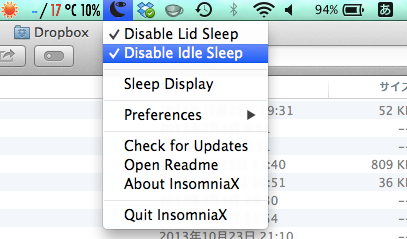

- INSOMNIAX DISABLE LID SLEEP NOT WORKING FOR MAC
- INSOMNIAX DISABLE LID SLEEP NOT WORKING MAC OS
- INSOMNIAX DISABLE LID SLEEP NOT WORKING FREE
But Applications is the most convenient place to put things, so we suggest you just put everything there.ĭMG files are mounted by your system, like a sort of virtual hard drive. Some people create a “Games” directory, to keep games separate from other applications. You don’t have to put your programs in the Applications folder, though: they’ll run from anywhere.
INSOMNIAX DISABLE LID SLEEP NOT WORKING FREE
Then you can feel free to delete the original DMG file: you don’t need it anymore.When you’re done installing: just click the “Eject” arrow.And you’re done: the InsomniaX is now installed.Simply drag the application’s icon to your Applications folder.
 Often these will include the application itself, some form of arrow, and a shortcut to the Applications folder.
Often these will include the application itself, some form of arrow, and a shortcut to the Applications folder. 
Double-click the DMG file to open it, and you’ll see a Finder window.dmg installation file from the official link on above
INSOMNIAX DISABLE LID SLEEP NOT WORKING FOR MAC
Like if you wanna download InsomniaX for mac from this page, you’ll directly get the.
INSOMNIAX DISABLE LID SLEEP NOT WORKING MAC OS
Most Mac OS applications downloaded from outside the App Store come inside a DMG file.
Release notes were unavailable when this listing was updated. InsomniaX for MAC Preview/caption] New Features InsomniaX disables either lid and/or idle sleep on your MacBook – any MacBook – allowing you to play music through speakers even while it’s closed or simply just to quickly stop the system from going to sleep on idle My hope is that with the laptop never sleeping, I can still have it scheduled to shut down when school is not in session (e.g., shut down between 8pm and 6am), check for Munki updates at 6am, and then just stay on (but with the lid shut) for the rest of the school day until the next evening.InsomniaX is a small utility that acts as a wrapper to the Insomnia kernel extension. InsomniaX is still figuring out its licensing ( For the time being this project is deemed to be “private code” and is not available for sharing, redistribution, inclusion in other works), so I’m leaning more toward NoSleep at this time. There are extensions that essential disable on the kernel level sleeping when the lid is closed. Doesn’t seem worth the effort/cost.Įxtensions that prevent sleep-on-lid-close That involves purchasing the adapters and then making sure they’re always plugged in. I don’t have the link handy right now, but I did stumble at one point on to some adapter that fakes have an external monitor plugged in. May be a good fallback to explore if the NoSleep option doesn’t work out. It’s certainly a lot of extra steps to get people who use a laptop cart, in addition to plugging in the power, to also plug in a wired ethernet connection (especially because new Mac laptops are ditching ethernet ports for Thunderbolt, which would require an adapter).Īpparently, you can do this wirelessly, but reading about Wake-on-Demand and sleep proxy makes my head hurt. 
I haven’t seen a lot of mention about this, but it doesn’t seem like a terribly viable option. I’m leaning toward NoSleep, but I don’t have a step-by-step tutorial ready just yet and won’t until I can test it extensively. So far, I’ve come across several possible solutions, which I’ll outline below. Even if you have, say, 20 laptops in a cart, manually opening each one and updating each one (even with an automated tool like Munki) can be a pain (and a time suck). However, if you administer laptop carts for a school, that can definitely get in the way of keeping them updated. So Mac laptops have this thing where they sleep when their lids are shut.








 0 kommentar(er)
0 kommentar(er)
